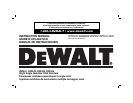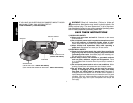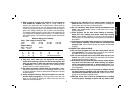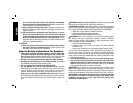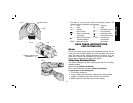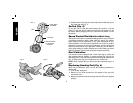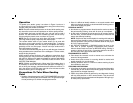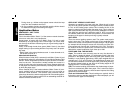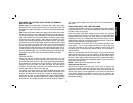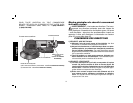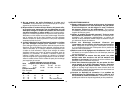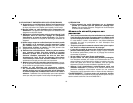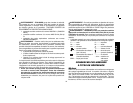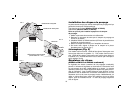
7
English
During clean up, children and pregnant women should be kept
away from the immediate work area.
c. All toys, washable furniture and utensils used by children should
be washed thoroughly before being used again.
Application Notes
SANDPAPER - GRIT TYPES
Natural Abrasives
Flint is the softest (Mohs’ Scale* 7) of the common natural abrasives.
It has a tan color and is very inexpensive.
Garnet paper is harder than flint (Mohs’ Scale 7.5) and is easily
identified by its bright orange color. Even though it is not the hard-
est, the way the abrasive fractures gives you a good cutting edge for
woodworking.
Emery, even though harder than garnet (Mohs’ Scale 9), has blunt
edges making it a poor sanding abrasive. Its primary use is for polish-
ing metal.
* Mohs’ Scale is the mineral hardness scale. It rates diamond at 15,
the hardest, and talc at 1.
Manufactured Abrasives
White Aluminum Oxide (AlO) is extremely hard (Mohs’ Scale 12) and
durable which makes it a great abrasive for use with the Random Orbit
Sander. “White” describes the particular way the abrasive is manufac-
tured, not its color. This abrasive is widely available and comes in a
variety of colors due to the increasing use of dyes. Stearate lubricants
on the paper also enhance performance by reducing heat and the rate
at which the paper clogs.
Silicon Carbide (SiC) is the hardest abrasive (Mohs’ Scale 13) com-
monly available next to industrial diamond but is not as tough as
Aluminum Oxide abrasives. This abrasive easily fractures and pro-
vides sharp faces to the work throughout the life of the sanding paper.
This “self-sharpening” feature makes SiC an outstanding abrasive for
material removal but limits its life.
OPEN COAT VERSUS CLOSED COAT
Abrasives are applied to the paper with glue. When the grit is large
(say 60 or 80 grit) the percent of coverage is usually reduced to 60%
to 70% of the backing paper surface.This increases the life of the
paper by reducing the rate at which the paper clogs. This is called an
open coat and almost the only way you can buy sandpaper in heavier
grits. With finer grits the grit is applied at rates of 90% or more and
are labeled closed coat. Since the dust particle is much smaller the
tendency of the paper to load up and clog is greatly reduced.
GRIT SIZES
There are several grading systems used. The system most popular
today is sieve size. The number on the back of your sandpaper disc
refers to the screen size the particle can pass through. 120 grit paper
for example will sift through a screen with 120 holes per linear inch.
Every square inch of screen has 14,400 holes (120 x 120). The higher
the number the finer the particle size. Common sizes are from 36 to
600 with the recent introduction of grit sizes up to 1200.
PAPER AND FILM: THE BACKING
Paper: The material most commonly used to carry the abrasive is
paper. Paper is graded by weight. “A” weight paper which is the most
prevalent is the lightest paper used and gives good durability and
flexibility in most sanding applications. Other paper weights that are
available are C, D, E, and F weight. The disadvantage of paper is its
low mechanical stiffness. Since the paper fiber gives during sanding,
the abrasive doesn’t stand up and some of the cutting edges do not
engage the work. The advantage is cost.
Film: Film backed sanding discs address the disadvantage of paper.
The film is mechanically stiffer than paper. Film is also more expen-
sive but when all other things are held constant improves the cutting
performance of the abrasive.
Cloth and Vulcanized Fiber: These backings are typically hard to
find and are used in specialty applications. Most sandpaper you will
use will have the paper or film backing.



